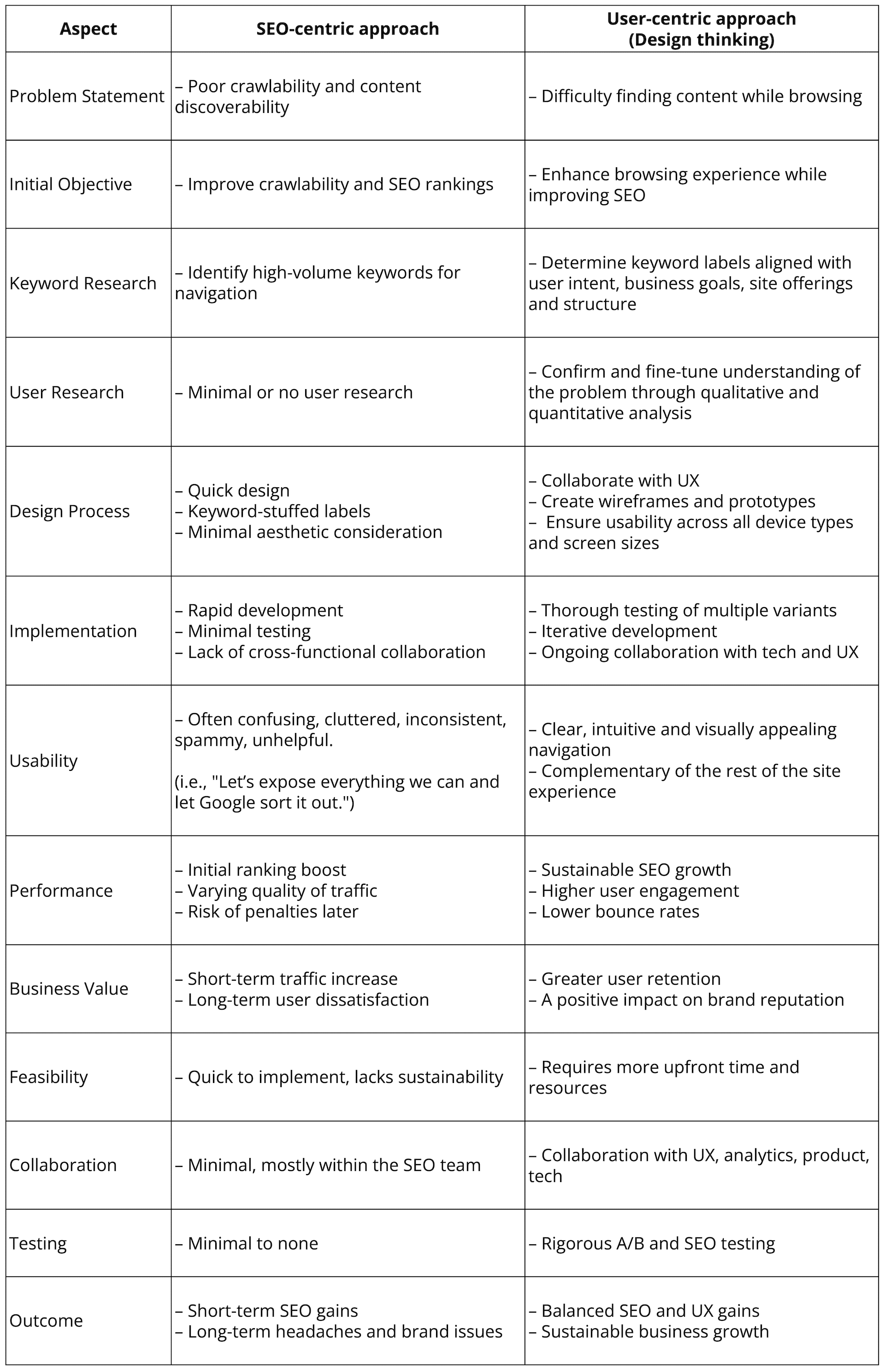
Design thinking is an iterative, user-centric approach to product and software development focusing on the person behind the problem.
In enterprise SEO, design thinking seamlessly integrates SEO features into the core site experience. By focusing on people as the central element in addressing both problems and solutions, design thinking leads to future-proof SEO.
Integrating this approach into enterprise SEO encourages team collaboration, ensuring SEO initiatives are practical, technically feasible and aligned with business goals, all while staying cost-effective.
Understanding design thinking in the context of SEO
Ingrained into the SEO process, design thinking shifts the focus from blindly optimizing for search engines toward creating value for the end user.
Many SEOs continue to seek to decipher the “200 ranking factors,” focusing on staying upstream of the never-ending slew of Google algorithm updates and guessing the next SERP layout change.
Resulting SEO “strategies” – or hacks – have a short shelf life, good only until the next core update. Focusing on the short-term works for SEO experimentation in high-risk, high-reward environments. But this is hardly the right approach for real businesses with an eye for long-term growth.
Design-driven and growth-oriented SEOs understand that the real and far more rewarding problem to crack is not the algorithm but the user. It requires knowing your audience, what they want and why and how to solve their problem given existing constraints.
Design thinking introduces a creative and systematic element to problem-solving. It involves understanding user needs, challenging assumptions, redefining problems, and creating innovative solutions for prototypes and tests.
The classic process typically includes five stages:
- Empathize.
- Define.
- Ideate.
- Prototype.
- Test.
Empathy
Understand users’ needs, behaviors and motivations.
- Who are your users and/or audiences?
- What problems are they looking to solve?
- What’s their immediate need?
- What’s their ultimate need?
Tackle these questions through persona building. For example, your business is a local classifieds site with various verticals. One of your many user segments could be newcomers to your country.
Immediately, they may be looking for a room or an apartment to rent. But ultimately, they are looking to settle down and build a new life. A classified ads site might be well-positioned to meet their needs at multiple stages of the journey.
Define
Clearly articulate SEO problems and goals based on user insights.
The immediate SEO goal here might be identifying the multitude of ways users may be signaling their intent through:
- Internal and external searches.
- Browsing patterns.
- Types of content viewed.
- Pageviews and searches that tend to occur within the same session.
Create a coherent content mapping that provides the right mix of relevant content to help capture the insights needed to address this overarching need.
Ideate
Brainstorm and generate a list of creative SEO strategies and solutions to address the problem.
Collaborate between analysts, designers, tech, marketers and product. This is the time to brainstorm, capture wild ideas, mull over desired outcomes, dream big and envision possible future states.
Ground the discussion in reality with an understanding of resourcing and tech constraints, immediate business priorities and more.
As enterprise SEOs often sit at the intersection of product, marketing, and tech, you can serve as an arbitrator who helps define some of the core requirements and guide the discussion.
Prototype
Develop proof-of-concepts (POCs) for testing and validating ideas. Simple, fast, low-lift POCs are a great way to validate assumptions and refine selected approaches.
Test
Evaluate solutions through multiple tests and qualitative and quantitative data, then iterate.
Any user-facing SEO changes should involve a two-part testing process.
- First, a limited rollout, an A/B experiment to understand the impact on user experience, engagement and conversion.
- The second should be an SEO test rolled out to all users but restricted to a small portion of the site to understand and confirm the impact on SEO performance before a large-scale rollout.
Dig deeper: Enterprise SEO: Why ‘best practices’ won’t cut it and what to do instead
Cross-functional teams for SEO
When SEOs work in isolation and are unsupported, it often results in mediocre strategies and the risk of a Google penalty, as they are forced to deliver results with limited resources while key decision-makers are distracted.
An SEO working as part of a larger design-oriented team equally invested in growth means shared ownership of outcomes and well-balanced, user-centric and SEO-friendly products.
In enterprise context, in addition to key SEO expertise or “Centers of Excellence,” SEO knowledge and responsibilities should be distributed far across various the organization.
Key roles that require at least some relevant SEO training include:
- Product managers.
- UX/UI designers.
- Developers.
- Content strategists.
- Data analysts.
- QA engineers.
Knowledge sharing and celebrating wins elevate curiosity, SEO expertise and morale.
Regular training sessions and detailed documentation will also help maintain acceptable SEO competence across large matrixed organizations.
Dig deeper: How to build an SEO-forward culture in enterprise organizations
Design thinking in action: Building a header navigation
Imagine you’re an SEO expert at a large ecommerce site. You noticed search engine bots struggle to find content and suspect a lack of consistent site header navigation could be the culprit.
The proposal is to introduce a header navigation, but the process makes all the difference.

Design thinking enhances enterprise SEO by promoting teamwork and focusing on user-centric solutions. It ensures SEO efforts are practical, feasible, and aligned with business goals.
By using design thinking, you can create sustainable, user-friendly SEO strategies for long-term growth.
Dig deeper: 6 steps to a winning enterprise SEO strategy
https://searchengineland.com/design-thinking-enterprise-seo-445053